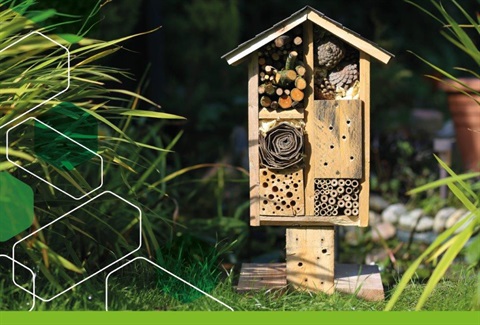Backyard habitat

Your yard is your very own piece of potential wildlife habitat. We can all ‘bring nature back’ to our yards and you don’t even need a big backyard to make a big difference.
Your garden can provide a smorgasbord of native plants, a butterfly sanctuary or frog haven, or even a busy native bee factory, nesting place. It can also provide a stopover point providing safe passage to wider local corridors for all kinds of feathered, furry, scaly or slimy friends.
Creating the perfect place for native wildlife in your backyard is as easy as making sure the basics are covered – much like us, this is about providing food, shelter and water for our local wildlife.
Food
One of the best ways you can improve your garden’s value for local wildlife is to add plants that provide food – in the form of nectar, fruit or seeds. Different birds and animals eat different things, so the more variety you have in your garden, the more birds and animals you will attract.
- Nectar plants like grevilleas and banksias feed nectar-eating birds and possums. Their flower heads also make a colourful addition to any garden. Plant one of these and watch nature come alive!
- Fruiting plants like lilly pillies feed birds, gliders, bandicoots and water-dragons. Why not plant a fruiting plant in your garden to help them out?
- Seed plants feed small woodland birds such as whistlers and little finches, which are finding life particularly tough in our urban environments. Other small birds eat the insects that live amongst grasses and low shrubs.
Through the Bringing Nature Back program, Council offers a free Native plant program for local residents and landholders. Keep an eye out at nominated events such as National Tree Day or subscribe to Council’s Sustainability e-Newsletter for further information on upcoming plant giveaways.
Shelter
Wildlife needs shelter to escape predators and raise young. Many different plants at varying heights create shelter and nesting opportunities for lots of birds and animals, while frogs, lizards and echidnas like to hide among low plants, rocks, logs and leaf litter.
There are many ways to provide shelter for wildlife in your garden. The more shelter you provide, the more wildlife that will come! Try adding a bug hotel to attract ladybirds, beetles and other bugs to your garden. Or add a nesting box or rock or brush pile to provide valuable hiding spots and nesting places for our local species.
Remember that one of the best ways you can protect local wildlife is to keep your cat indoors at night.
Water
Wildlife need water – and not just for drinking. Birds preen their feathers with it and frogs need it to stop their porous skin from drying out.
Installing a water feature doesn’t have to be expensive. A simple bird bath or water bowl will often attract more species of birds than a feeder, and parent birds will bring their babies to show them where it is. Your garden might already have a natural depression which you can make into a shallow pool – creating a haven for small insects and frogs. A larger pond will create great habitat for fish, frogs, lizards, insects, turtles and ducks. And don’t forget to put your water feature where you can see it, maintain it and enjoy the show!
For more tips on adding food, shelter and water to your garden, visit Backyard Buddies.